Charlotte Brudenell's Lace Collection
Deene Park is a home full of precious objects and sentimental family treasures that have been amassed over several centuries, and this year we are very proud to add a beautiful collection of lace to our displays.
This family collection from Bockleton Court in Worcestershire was assembled by Mary Prescott, Charlotte Brudenell’s great Aunt, and includes lace from France, Spain, Venice, Brussels, England and Ireland.
Linen, cotton and silk have all been used with varying techniques and brought together to show a comprehensive collection of the history of needle lace.
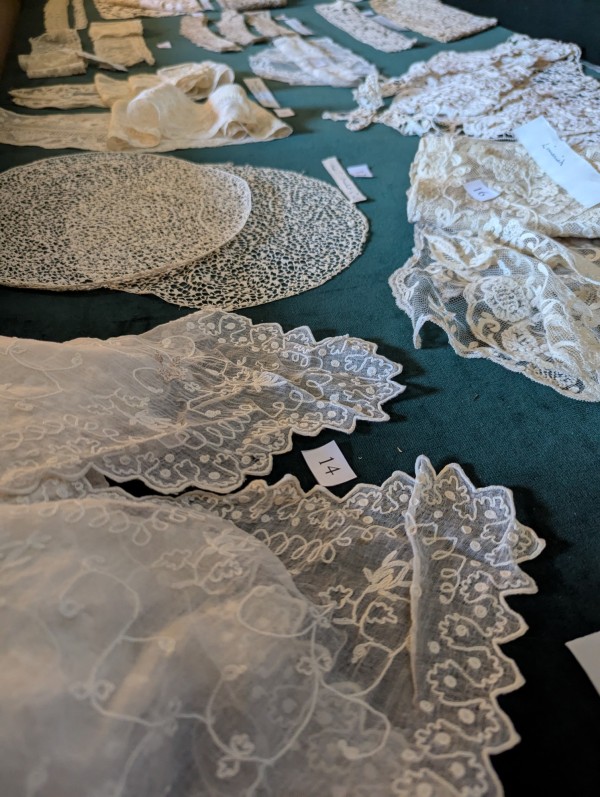 |
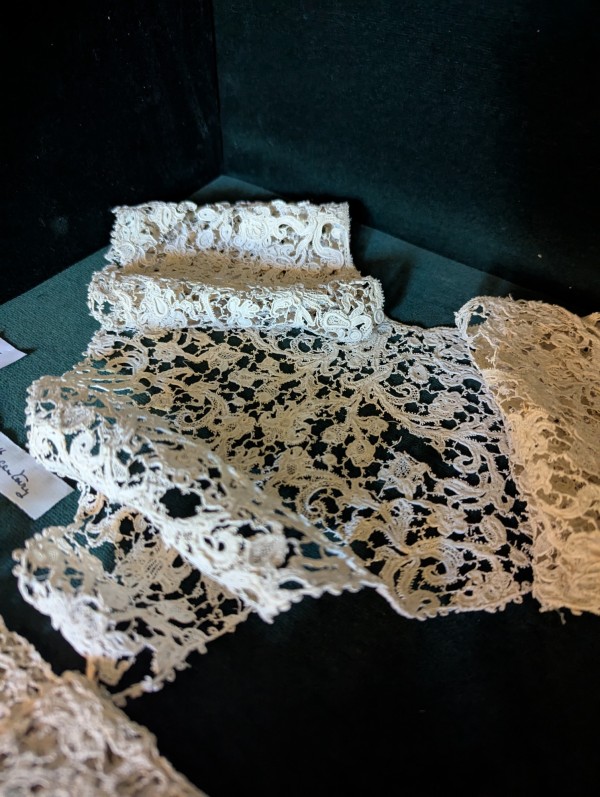 |
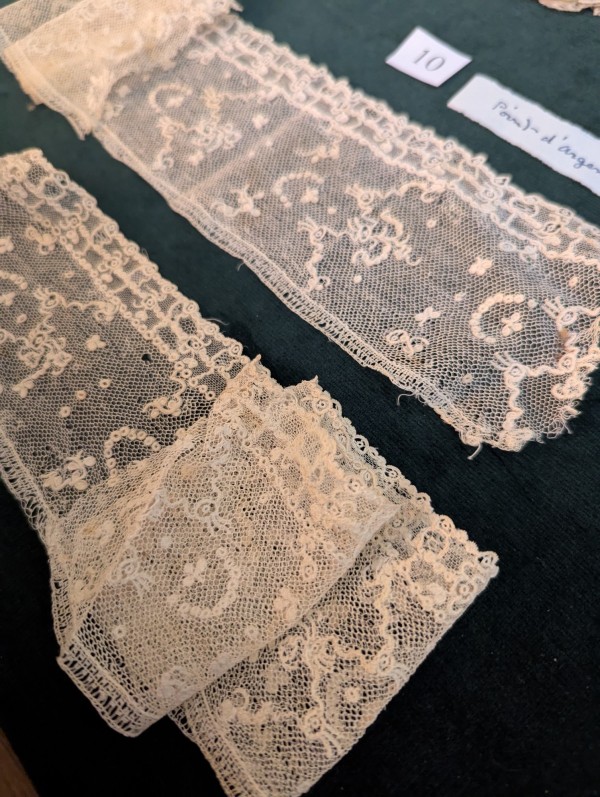 |
| Lace Collection | French Point de France Needle Lace Collar, circa 1680’s | Early 18th-century pieces from D’Argentan, Normandy |
WHAT IS LACE?
The Latin word from which "lace" is derived means "noose," and a noose describes an open space outlined with rope or thread. This description applies to many types of open fabric resulting from "looping, plaiting, twisting, or knotting...threads...by hand or machine."
There are many types of lace, classified by how they are made. These include:
Needle lace, such as Venetian Gros Point, is made using a needle and thread. This is the most flexible of the lace-making arts. While some types can be made more quickly than the finest of bobbin laces, others are very time-consuming. Some purists regard needle lace as the height of lace-making. The finest antique needle laces were made from a very fine thread that is not manufactured today.
Bobbin lace, as the name suggests, is made with bobbins and a pillow. The bobbins, turned from wood, bone, or plastic, hold threads which are woven together and held in place with pins stuck in the pattern on the pillow. The pillow contains straw, preferably oat straw or other materials such as sawdust.
Crocheted lace includes Irish crochet, pineapple crochet, and filet crochet.
Cutwork, or whitework, is lace constructed by removing threads from a woven background, and the remaining threads wrapped or filled with embroidery.
Machine-made lace is any style of lace created or replicated using mechanical means.
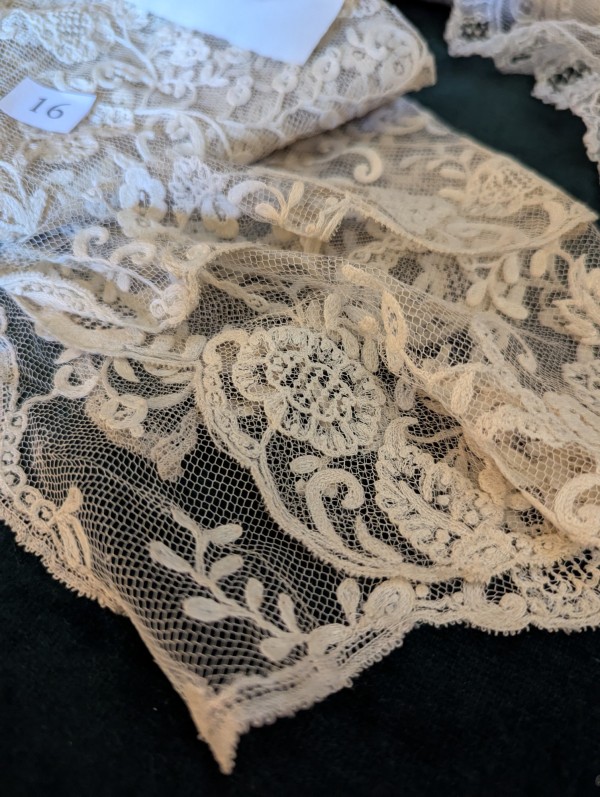 |
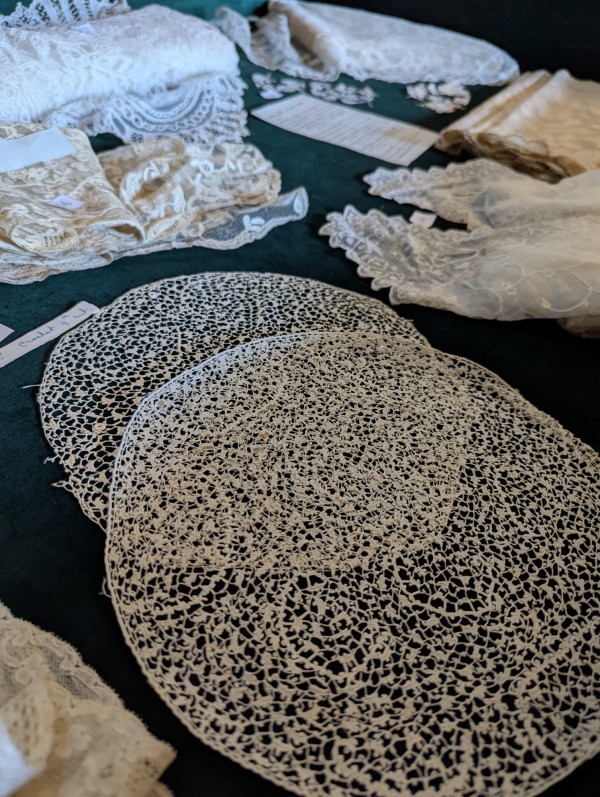 |
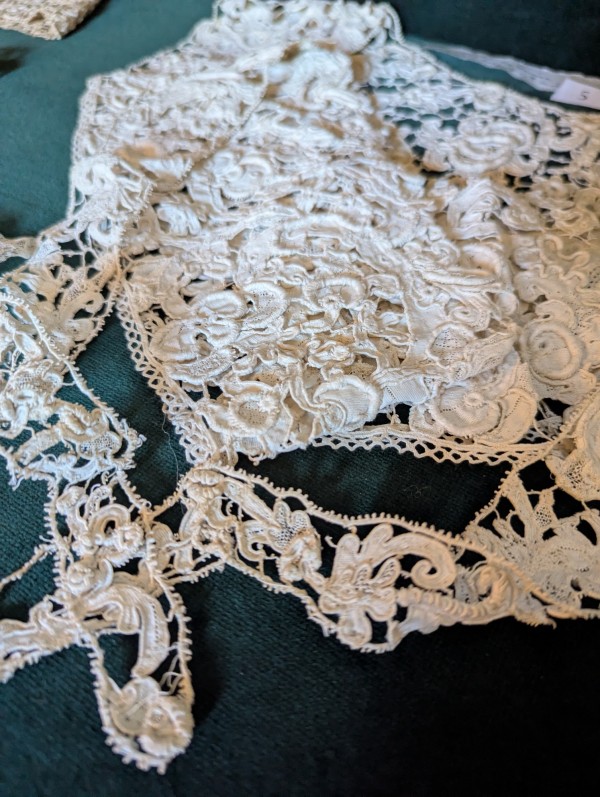 |
| Limerick lace stole. | Crochet linen table centres. | Charles II, high-quality Gross Point collar and cuff. |
HISTORY OF LACE
The origin of lace is disputed by historians. An Italian claim is a will of 1493 by the Milanese Sforza family. A Flemish claim is lace on the alb of a worshipping priest in a painting about 1485 by Hans Memling. But since lace evolved from other techniques, it is impossible to say that it originated in any one place. The fragility of lace also means that few exceedingly old specimens are extant.
Lace was used by the clergy of the Catholic Church as part of vestments in religious ceremonies. When they first started to use lace and through the 16th century, they primarily used cutwork. Much of their lace was made of gold, silver, and silk. Wealthy people began to use such expensive lace in clothing trimmings and furnishings, such as cushion covers. In the 1300s and 1400s in the Italian states, heavy duties were imposed on lace, and strict sumptuary laws were passed. This led to less demand for lace. In the mid-1400s, some lacemakers turned to using flax, which cost less, while others migrated, bringing the industry to other countries.
However, lace did not come into widespread use until the 16th century in the northwestern part of the European continent. The popularity of lace increased rapidly, and the cottage industry of lace-making spread throughout Europe. The late 16th century marked the rapid development of lace, both needle lace and bobbin lace became dominant in both fashion as well as home décor. To enhance the beauty of collars and cuffs, needle lace was embroidered with loops and picots.
In the 17th and 18th Centuries, Lace continued to be a popular textile, with styles changing to meet fashion demands.
The Industrial Revolution brought about machine-made lace, making it more accessible and less expensive. Lace collars and other embellishments were worn by both men and women, signifying status and sophistication. The invention of the Leavers loom in the early 1800s, particularly in Nottingham, England, further mechanized the process of lacemaking.
By the mid-19th century, machine-made lace became widespread, leading to the decline of the handmade lace industry in many regions. The 20th century saw a revival of handmade lace as a craft, undertaken for challenge and recreation.
WHERE WAS EUROPEAN LACE MADE?
Italy
Bobbin and needle lace were both being made in Italy early in the 1400s. Documenting lace in Italy in the 15th century is a list of fine laces from the inventory of Beatrice d'Este, Duchess of Milan, from 1493.
Venice
In Venice, lace making was originally the province of leisured noblewomen, who used it as a pastime. Some of the wives of doges also supported lacemaking in the Republic. In 1595, Morosina Morosini, a doge's wife, founded a lace workshop for 130 women. In the early 1500s, the production of lace became a paid activity, accomplished by young girls working in the houses of noblewomen, creating lace for household use, and in convents. Lace was a popular Venetian export in the 1500s and 1600s, and the demand remained strong in Europe, even when the export of other items exported by Venice during this period slumped.
The largest and most intricate pieces of Venetian lace became ruffs and collars for members of the nobility and for aristocrats.
Spain
Lacemaking in Spain was established early, as by the 1600s its Point d'Espagne lace, made of gold and silver thread, was very popular. Lace was made for use in churches and for the mantilla. Lacemaking may have come to Spain from Italy in the 1500s, or from Flanders, its province at the time. This lace was much admired and was made throughout the country.
Belgium
Lace was being made in Brussels in the 1400s, and samples of such lace survive. Belgium and Flanders became a major centre for the creation of primarily bobbin lace starting in the 1500s, and some handmade lace is still being produced there today. Belgian-grown flax contributed to the lace industry in the country. It produced extremely fine linen threads that were a critical factor in the superior texture and quality of Belgian lace. Schools were founded to teach lacemaking to the young. The height of the production of lace there was in the 1700s. Brussels was known for Point d'Angleterre.
Belgian lacemakers either originated or developed laces such as Brussels or Brabant Lace, Lace of Flanders, Mechlin, Valenciennes and Binche.
France
Lace arrived in France when Catherine de Medici, newly married to King Henry II in 1533, brought Venetian lace-makers to her new homeland. The French royal court and the fashions popular there, influenced the lace that started to be made in France. It was delicate and graceful, compared to the heavier needle or point-laces of Venice. Examples of French lace are Alençon, Argentan, and Chantilly. The 17th century court of King Louis the XIV of France was known for its extravagance, and during his reign lace, particularly the delicate Alençon and Argentan varieties, was extremely popular as court dress. The frontange, a tall lace headdress, became fashionable in France at this time. Louis XIV's finance minister, Jean Baptiste Colbert, strengthened the lace industry by establishing lace schools and workshops in the country.
England
The lace that was made in England prior to the introduction of bobbin lace in the mid 1500s was primarily cutwork or drawn thread work. There is a 1554 mention of Sir Thomas Wyatt wearing a ruff trimmed with bone lace (some bobbins at the time were made of bone). The court of Queen Elizabeth I of England maintained close ties with the French court, and so French lace began to be seen and appreciated in England. Lace was used on her court gowns and became fashionable.
There are two distinct areas of England where lacemaking was a significant industry: Devon and part of the South Midlands. Belgian lacemakers were encouraged to settle in Honiton in Devon at the end of the 16th century.
They continued to make pillow and other lace, as they had in their homeland. While the lace in Devon stayed stable, in the lace-making areas of the South Midlands there were changes brought by different groups of émigrés: Flemings, French Huguenots, and later, French escaping the Revolution.
Catherine of Aragon, while exiled in Ampthill, England, was said to have supported the lace makers thereby burning all her lace and commissioning new pieces. This may be the origin of the lacemaker's holiday, Cattern's Day. On this day (25 or 26 November) lacemakers were given a day off from work, and Cattern cakes - small dough cakes made with caraway seeds, were used to celebrate. The English diarist Samuel Pepys often wrote about the lace used for his, his wife's, and his acquaintances' clothing, and on 10 May 1669, noted that he intended to remove the gold lace from the sleeves of his coat "as it is fit [he] should", possibly to avoid charges of ostentatious living.
In 1840, Britain's Queen Victoria was married in lace, influencing the wedding dress style until now. The decline of the lace industry in England began about 1780, as was happening elsewhere. Some of the reasons include the increased popularity of clothing in the Classical style, the economic issues connected to war, and the increased production and use of machine-made laces.
Ireland
Lace was made in Ireland from the 1730s onwards with several different lace-making schools founded across the country. Many regions acquired a name for high-quality work and others developed a distinctive style. Lace proved to be an important means of income for many poorer women. Several important schools of lace included: Carrickmacross lace, Kenmare lace, Limerick lace and Youghal lace.
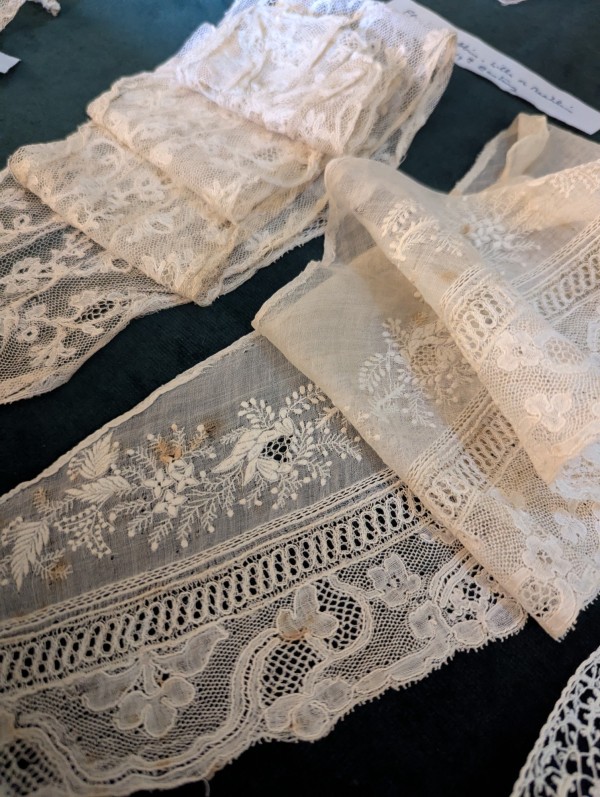 |
 |
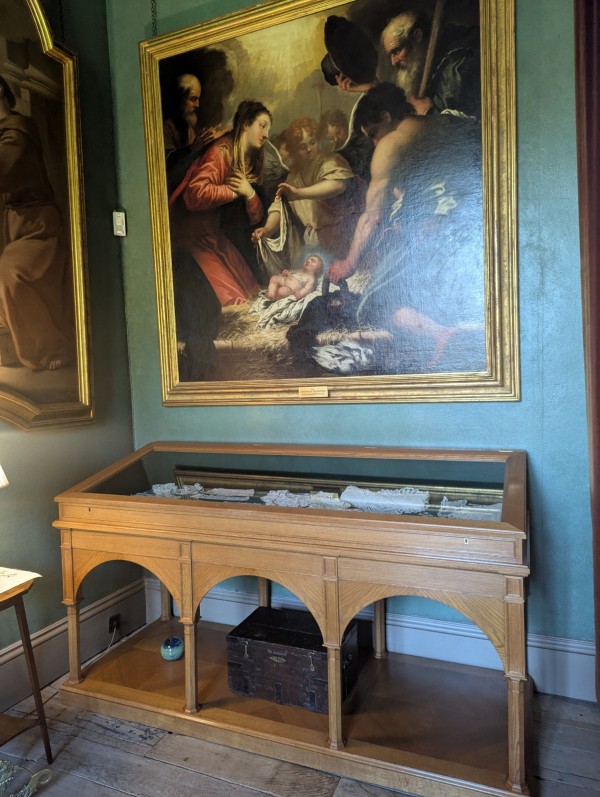 |
| Bobbin linen needle lace. Early 19th century | Large Flemish Fichu, late 19th Century | Lace display cabinet |
Deene Park, known as the House of Beauty, House of Stitch and House of Dog truly lives up to its name with this carefully curated permanent exhibition.
Charlotte Brudenell's lace collection is on display in the Tapestry Room, a room that is accessible to the public on our open days during May, June, July, and August. For more information, and to book tickets please click HERE.
With thanks to Waddesdon Manor for gifting Deene Park the beautiful display case.

